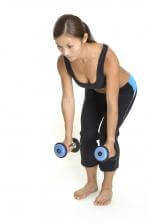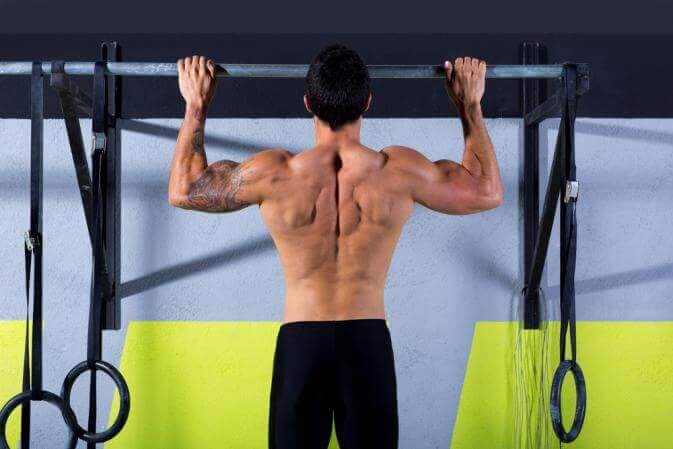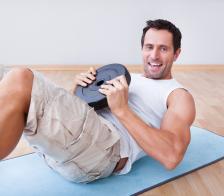The Best Exercises for 7 Popular Trouble Spots (Part 2)
Find out the best butt, hip and thigh exercises, the best calf exercises, the best chest exercises, the best shoulder exercises, the best back exercises, the best arm exercises and the best ab exercises in this 2-part series. In part 2, you’ll learn how to target the shoulders, back, arms, and abs.
Ben Greenfield
Listen
The Best Exercises for 7 Popular Trouble Spots (Part 2)
In Part 1 of this series on the best exercises for 7 popular trouble spots, you learned the best exercises to tackle and tone the troublesome areas of your butt, thighs, hips, and chest. In this episode, we’re going to focus on your shoulders, back, arms, and abs..
Shoulders

You need to perform 2 different exercises because the deltoid muscles in your shoulders a.k.a. “delts” are actually comprised of 3 distinct sets of muscle fibers – each of which can be targeted with different moves. So you need to come at your shoulder from a variety of different angles.
For a lateral delt raise, simply stand with your arms at your side holding a weight such as a dumbbell in each hand, then, keeping your arms as straight as possible, raise the dumbbells out to the side until they are parallel to your shoulders. Finally, slowly lower the weights back to the start position.
The movement for a rear delt raise is very similar, but this time, you’re bent over with your butt out behind you and a straight back, and you start with the dumbbells hanging below your chest. Then you raise the dumbbells (as if your arms were airplane wings) towards the ceiling while squeezing your shoulder blades together.

Back
Your back is comprised of many different muscles, but when it comes to your posture, how you look in a t-shirt or swimsuit, or how you look with your shirt off, there are 3 specific muscle groups that you really need to target: your upper trapezius a.k.a. “traps,” your mid-trapezius, and your latissimus dorsi a.k.a. “lats.”
The trapezius is a large muscle that extends from the back of your head all the way down to your mid-back, and is responsible for moving your shoulder blades and supporting your arms. Your latissimus is the larger, flat “wing-shaped” muscle that extends from your spine all the way out to underneath your armpits. One of its primary purposes is to engage in upper body pulling. A nice, toned trapezius and lattisimus dorsi form the foundation of a good-looking back!
Nothing beats a basic shoulder shrug for the upper traps. This exercise is as simple as it sounds. Simply stand with a weight at your side and shrug – with a goal of driving your shoulders all the way up to reach the bottom of your ears. Hold for 1 or 2 seconds, then lower.
For the mid-traps, you’ll want to do bent-over rows. There are many versions of bent-over rows, but my favorite is to simply bend over with a straight back, in a lunging position, with your body weight supported over both legs. In this position, you should be holding a dumbbell in one hand. Then simply row that dumbbell as high as possible, as if you were starting a lawnmower. Hold for 1 or 2 seconds, then lower.
Finally, for your lats, there is nothing better than a pull-up or a pull-down. For either of these exercises, try to grip the bar that you are pulling towards your chest with a “thumbs-off” grip, because this will activate more of your back muscles.
Arms
To get nice arms – or to justify wearing that “Welcome to The Gun Show” t-shirt, you’ll want to work both your biceps and your triceps.
The very best exercise for the biceps (the front of your arms) is similar to one of the best exercises for your back: a chin-up. So what’s the difference between a pull-up and a chin-up? A pull-up is performed with your knuckles facing you, while a chin-up is performing with you knuckles turned away from you. If you can’t do a chin-up, just do a cable pull-down with your knuckles turned away from you, also known as a cable underhand pull-down.
For your triceps (the back of your arms), triceps extensions are the best exercise. A simple version of the triceps extensions exercises that you can perform with minimal equipment is a standing overhead triceps extension.
For a standing overhead triceps extension, stand with your elbows overhead and a dumbbell (or any other weight) grasped in both hands, and lower the weight back behind your head by flexing your elbows. Try to get your elbows bent to 90 degrees. Then raise the weight back over your head by extending your elbows.
Abs
A simple search for “abs” over at the QuickAndDirtyTips website will reveal a number of articles I’ve written on that ever-elusive goal of a flat stomach or a six-pack abs, including “How to Get Abs Like Magic Mike” and “How To Get Washboard Abs – Fast!”
But what does electromyography (which you learned all about in Part 1 of this series) reveal about maximum activation of abdominal muscle tissue? It turns out that the 3 exercises that maximally stimulate your stomach are hanging leg raises, weighted crunches, and ab wheel rollouts.
For a hanging leg raise, grasp and hang from a bar with slightly wider than shoulder width overhand grip, then raise your legs by flexing hips and knees until your hips are completely flexed or knees are well above hips.

And finally, an ab wheel rollout uses that funky contraption that looks like some kid accidentally left their tricycle wheel at the gym. An ab wheel is basically a small wheel with a handle through the center of it.
To do an ab-wheel rollout, begin by kneeling on the floor (you’ll want a mat under your knees – trust me)! Grasp the handles on either side of the wheel with an overhand grip, then keeping your arms straight, roll the wheel out as far as possible as you extend your body forward. This is harder than it sounds! Next, bring your body back up to the starting position by flexing your abs. Warning: Doing this exercise properly is not for the faint of heart!
If you have more questions about the best exercises for your shoulders, back, arms and abs, then leave them over at Facebook GetFitGuy.
Images courtesy of Shutterstock

